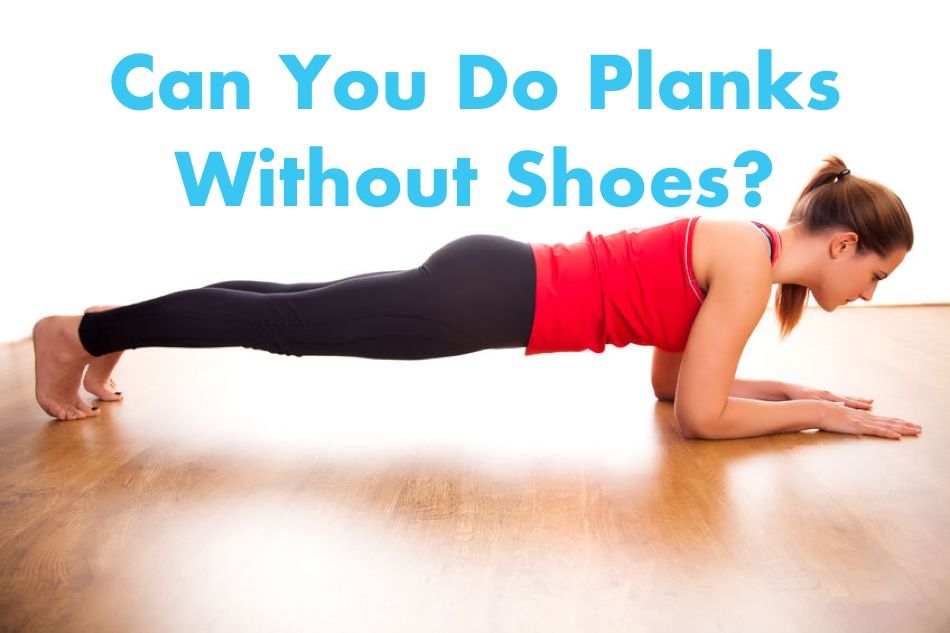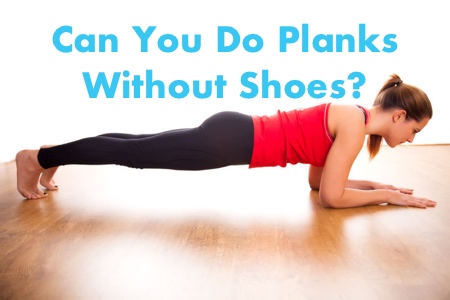
Yes indeed you can do planks without shoes
Can You Do Planks Without Shoes?
Table of Contents
If you have been working out barefoot for any period, you may inevitably come to the point where the question crops up as to the exercises you can do without shoes. There are quite a few exercises that can you can do without shoes.
Can you do planks without shoes? You can do a plank without shoes yes. All you will need is a little bit of time for your feet to get used doing the exercise. You will also need to be mindful of the surface you are doing the plank on. Wherever you choose, indoors or outdoors, if you master some simple drills, it can be done.
I will walk you through everything you will need to know to be able to do the plank barefoot.
What is a plank
Back in the day when I was a child, We called the plank the front support. Whichever name we know it as it is essentially the beginning or top position of a pushup. Planks are a very effective core exercise that is brilliant for working out muscle imbalances, correcting lower back issues and poor posture.
There are subtle variations of the form a plank takes, these include:
- You are upright on the top of push-up position on the hands
- You are upright on the top of push-up position but on the elbows
- You are erect, elongated body in the sideways position on the hands
- You are erect, elongated body in the sideways position on the elbow
So you can either be facing the ground or facing the wall if you like.
How To Do A Plank Barefoot
1) Arm Set-Up – Get your elbows directly in line with your shoulders. Keep the weight of your upper body evenly distributed over your upper arms in line with your elbows. Your hand and forearms should be pointed forward or in whatever direction is most comfortable if you are a beginner. Make sure your elbows are not overextended.
2) Shoulder Set-Up – Contract your shoulders into the ribcage, this will ensure that the extended arms are locked into position your core muscles. Finally, contract your lat muscles to lock the shoulders into position with your torso.
3) Spine Set-Up – Get the spine lengthened in both directions. Keep your head in the neutral position looking down at the floor. Make sure you can trace a straight line from your head to the hip to the ankles. Aim to keep your spine in a neutral position by not overextending or arching your spine. Keep your spine long throughout the exercise.
4) Core and Glute Set-Up – Actively engage your core muscles with a gentle contraction and hold added to contracting your glute muscles. While you are doing this, make sure you remember to breathe (more on this later).
5) Foot Set-Up – Balancing on the balls of your feet, drive back into the ground by contracting your quad muscles, this will extend your knees. Push your feet back into the ground, which will drive your heels backwards in combination with the knee extension. Keep your feet is hip-width to avoid stress on your hips. Doing this will flex your feet forward and backwards and increase your strength and range of motion in your ankles.
6) Breathing Set-Up – Once you have put yourself into position and engaged your core and glute, slowly expel the air from your lungs until most or all of it is removed. Let yourself inhale as you relax your lungs and throat. Once you have filled your lungs with air, repeat for the duration of the exercise.
Barefoot Plank Variations
Let take a close looker at some of the plank types:
1. Scaled Plank – This is the scaled down version that’s perfect for beginners. In this variation, you start with your knees on the ground until you build up enough strength to do the simple plank. The scaled plank is the foundational building block for building strength and core stability. You can either do this on with your arm locked out or on your elbows. Be mindful to ensure that your core is tight and engaged along with the rest of your body
2. Simple Plank – The simple plank moves one step up from the scaled plank. You do this movement without the need to kneel anymore. With the simple plank, your body should be fully extended with you on your toes or balls of your feet, working from your elbows and forearms.
3. Standard Plank – For the Standard plank you are at the top of a full push up. Make sure your arms are straight, and your hips are in line with your head and ankles. You do this variation with your palms on the ground instead of on your elbows and forearms. Some people find this one a bit easier to do than the simple plank.
When you are doing this type of plank remember to keep your elbows soft and all your fingers facing dead ahead. Open your hands as wide as possible to get a good grip on the ground.
5. Side Plank – Get into the sideways position. Choose any side that works for you. Lying on your side one foot on top of the other make sure your elbow is directly under your shoulder, and your hips are off the floor in line with your head and feet. All the while keeping your core muscles tight and engaged.
A twist you can add would be to extend your other arm up towards the ceiling or place it on your hip. You will probably find that you are stronger on one side than the other. Bear that in mind and make sure you work both sides, so you balance them out strength wise.
Five Other Exercises You Can Do Barefoot
Lets have a look at the other exercises you can do with no shoes.
1. Barefoot Push-Ups
One of my favourite exercises, I do them in the morning as soon as I get up. It is this exercise that is the follow on from the plank. So it is safe to conclude that if we can plank barefoot, we can most definitely do push-ups barefoot too. Gripping the floor with the toes gives your feet a good stretch as well as working your muscles and joints.
2. Barefoot Deadlifts
Deadlifting is one of the best essential exercises you can perform. Doing it without shoes mean you will have t be careful not to drop anything on your feet. Some gyms need you to wear shoes some don’t so bear that in mind. Barefoot deadlifting let you feel the ground better and eliminates the forward tilt you get from wearing weightlifting shoes.
3. Barefoot Squats
Barefoot squats with a bar, Air squats whichever variation require you to activate the core and hip complex too. The basic movement mimics you sitting on a chair in s controlled manner. You shift your weight backwards with an upright torso as you descend.
Fitness experts generally agree that squatting barefoot strengthens your feet and helps you to avoid future problems.
4. Barefoot Walking Lunges
Walking lunges, in my view, are more comfortable without shoes. Start with no weights if you are new to barefoot workouts. During the lunge, use your entire foot to grip the floor as best you can. Lunging barefoot will help you experience a more grounded feel. The expanding of your feet and spreading of your toes gives you a brilliant base to get you going.
5. Barefoot Kettlebell Swings
Barefoot kettlebell swings or KBS as I like to call them are a brilliant whole body work out exercise. The movement aid in building the core and adding to the development of core strength in the hips especially. Doing this movement barefoot gives your body an excellent feel and grip of the floor. Keeping good form and driving from the heels as you execute the sequence.
You will need to grab the kettlebell keeping your hips back shoulders down, lats engaged, ready to pull the kettlebell off the ground. Next Hike the bell into the backswing as hard as you can. Then you Hinge and drive your butt backwards, and then explosively open up your hips fully standing upright into the swing. The Root is where all the squeezing happens, activate the shoulders, quads and the glutes together grabbing the ground with your entire foot. Finally, float the Kettlebell on the ascent to give you a little rest in between reps. The more explosive the hinge, the more the float of the kettlebell.
Wrap-up
Doing the plank without any shoes is an excellent exercise to have in your training arsenal. The exercise helps you to build your core muscles which are essential to optimal health and fitness.
It forms a mini-complex of exercises that can be done barefoot in whichever definition you choose. That may be with no shoes, with socks or minimalist shoes.
We looked at the other exercises you can do with no shoes:
- Push-Ups
- Deadlift
- Squats
- Walking lunges
- Kettlebell Swings
Once you dial in the correct technique with practice, you will have a much stronger base for all the other exercises we have looked at in this article. Increased foot strength and flexibility is a benefit of doing the plank with no shoes; this asset is easily transferable to the other movements we have looked at. check out a more detailed post on foot strengthening exercises here
So, give it a try it’s a novel experience, but fun too enjoy
